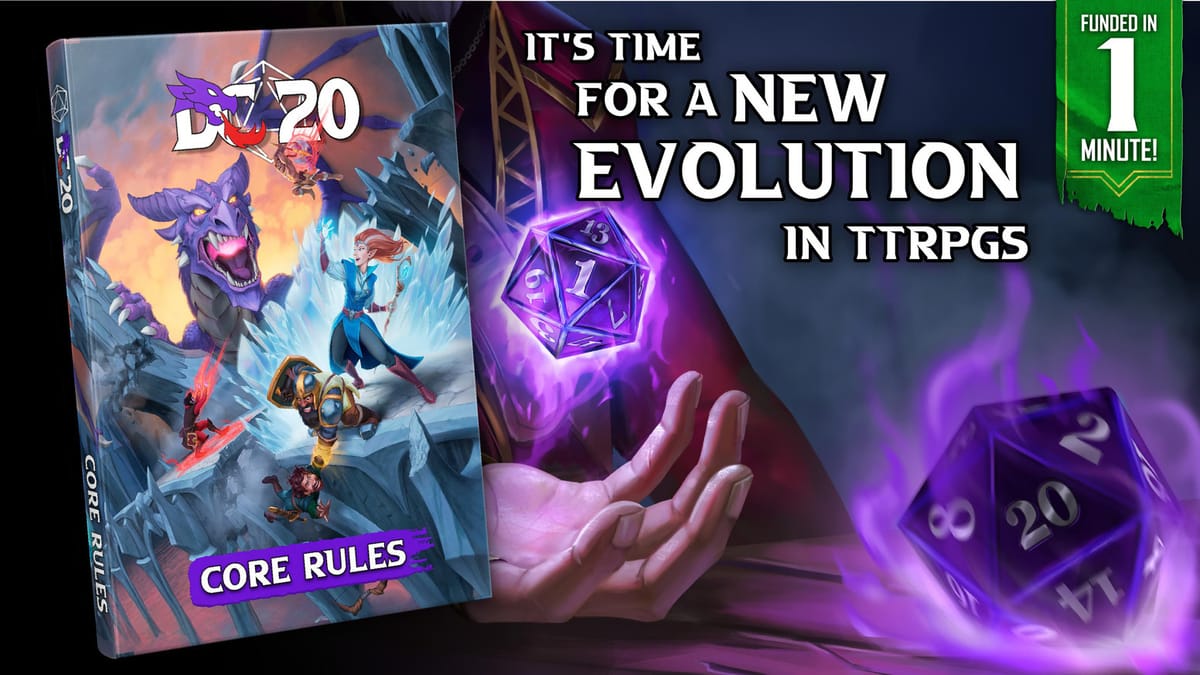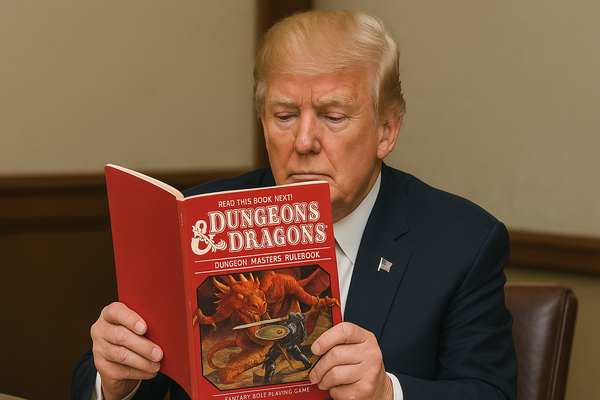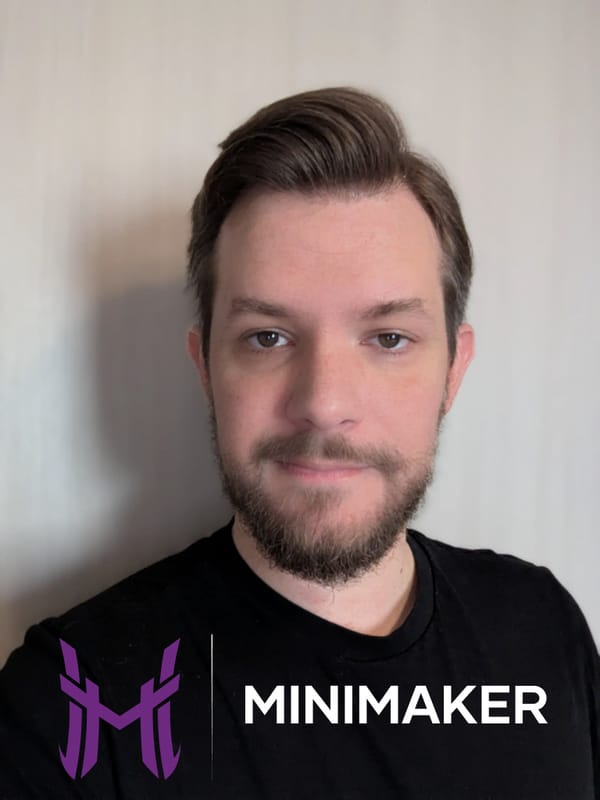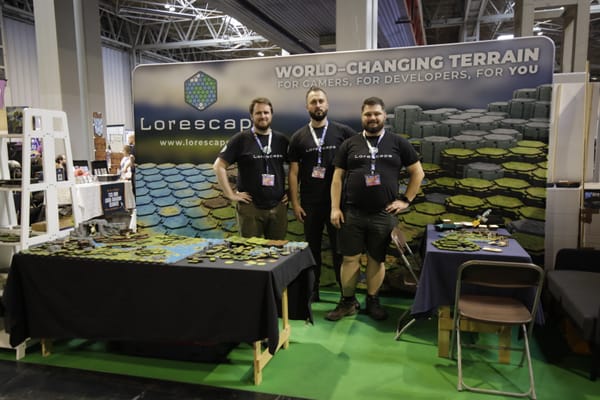Analysis of Top 10 Highest-Funded Tabletop Games on Kickstarter (2024)

The Top 10 highest-funded Tabletop Games of 2024:
- Brandon Sanderson's Cosmere® RPG by Brotherwise Games – Raised $15.1M+ from 55,106 backers, the highest-funded Games project of all time
- Altered TCG by Equinox – Raised $6.7M+ from 14,997 backers, the highest-funded trading card game in Kickstarter history
- Trench Crusade by Factory Fortress INC – Raised $3.3M+ from 20,170 backers
- Twisted Cryptids by Ramy Badie – Raised $3.1M+ from 33,210 backers
- Terry Pratchett's Discworld RPG: Adventures in Ankh-Morpork by Modiphius Entertainment – Raised $3.0M+ from 17,223 backers
- Root: The Homeland Expansion by Patrick Leder – Raised $2.4M+ from 27,549 backers
- DC20 by The Dungeon Coach – Raised $2.2M+ from 20,684 backers
- Terraria: The Board Game by Paper Fort Games – Raised $2M+ from 15,237 backers
- Return To The 7th Citadel by Serious Poulp – Raised $1.7M+ from 15,137 backers
- Thunder Road: Vendetta - Carnival of Chaos by Restoration Games – Raised $1.6M+ from 13,460 backers
Comparison of Funding Trends
The top 10 tabletop game campaigns of 2024 raised extraordinary funds, led by Brandon Sanderson’s Cosmere® RPG at a record-breaking $15.1 million from over 55,000 backers (2024 Was a Big Year for Games on Kickstarter). This made Cosmere not only the biggest tabletop project of 2024 but the highest-funded games project ever on Kickstarter.
Notably, it stands far above the second place, Altered TCG, which raised $6.7 million. There’s a steep drop after these two mega-hits – the third through tenth projects each raised between ~$3.3 million and $1.6 million.
In other words, Cosmere amassed more than double the funds of any other 2024 tabletop campaign, highlighting its outlier status. Overall, the top 10 campaigns together pulled in roughly $40+ million, a significant chunk of the $220 million pledged to all successful tabletop game projects in 2024.
All these campaigns showed similar funding patterns over their campaign lifecycles. Nearly all experienced explosive starts on launch day and strong final surges in the last 48 hours, with quieter periods in between – a classic “Kickstarter curve.” For example, Cosmere RPG raised over $5 million in its first 24 hours alone (Brandon Sanderson's Cosmere RPG Kickstarter Raised $5 Million In One Day | TechRaptor), instantly achieving 20× its initial goal and setting an early momentum.
Similarly, the Altered TCG campaign “breezed past $1 million on its first day” (Altered becomes biggest-ever TCG Kickstarter after raising $7m for groundbreaking approach to collecting cards | Dicebreaker), a remarkable day-one haul that signaled it as a breakout project in the trading card game space. Most of the top campaigns had five- to six-figure backer counts, so an enthusiastic fan rush at launch translated to millions in a single day.
After the initial spike, mid-campaign periods tended to plateau or grow steadily, then a final spike occurred as last-minute backers and 48-hour reminder notifications poured in. In Cosmere’s case, the final days saw it leap from ~$11M to over $15M, breaking past long-standing Kickstarter records in that home stretch (Brandon Sanderson's Cosmere® RPG by Brotherwise Games :: Kicktraq)
We see similar endgame surges in other campaigns as well – backers jumped in before the deadline, pushing Twisted Cryptids over $3.1M and Trench Crusade past $3.3M by their finales.
Another notable trend is the varying average pledge size, reflecting different pricing strategies and backer behaviors. Cosmere’s campaign, offering deluxe RPG book sets, had an average pledge around $276 per backer - indicating many backers opted for high-tier bundles.
By contrast, a game like Twisted Cryptids, with 33,210 backers contributing $3.1M, saw a much lower average (~$93 each), suggesting a more affordable base game and many casual backers. Altered TCG stood out with an exceptionally high average pledge (about $446), since 14,997 backers contributed $6.7M - likely due to collectors buying large booster packs or premium tiers.
In summary, projects with premium content (multiple books, big expansions, or collector’s items) saw higher per-backer spends, whereas those with mass appeal or lower price points attracted more backers at smaller individual pledges. Despite these differences, all top 10 campaigns hit massive funding milestones relative to their goals, and most far exceeded their initial targets by thousands of percent.
Established IPs vs. New Concepts
One clear pattern in 2024’s top campaigns is the power of established IPs (intellectual properties). Half of the top 10 projects rode into Kickstarter on the shoulders of well-known franchises or titles. For example, Brandon Sanderson’s Cosmere RPG capitalized on the huge pre-existing fanbase of Sanderson’s Cosmere novel universe.
That built-in audience translated to record support – over 55k fans backing the project and propelling it to all-time high funding . Similarly, Terry Pratchett’s Discworld RPG leveraged a beloved literary IP; Discworld’s popularity (especially in the UK) helped it raise about $3.0M from 17k backers, an impressive figure for an RPG.
The backer community for Discworld was uniquely heavy with UK supporters (nearly 30% from the UK alone) (Terry Pratchett's Discworld RPG: Adventures in Ankh-Morpork), reflecting how tapping an existing franchise rallies its devoted regional fanbase.
Other campaigns also drew on known brands: Terraria: The Board Game was based on a hit video game, attracting many of that game’s 35+ million players – it ended with $2M funded, aided by official promotion from the Terraria developers. Root: The Homeland Expansion built on the award-winning Root board game’s popularity, and Thunder Road: Vendetta – Carnival of Chaos revived a classic 1980s board game brand.
These IP-based projects had a head start in gaining trust and visibility; fans were eager to support the games that let them dive deeper into their favorite worlds.
In contrast, several top projects were original games or new IPs, proving that innovative concepts with strong execution can thrive without a famous license. Altered TCG is a great example - it wasn’t tied to an existing pop-culture property, yet it became the highest-funded trading card game in Kickstarter history.
Altered’s success was driven by its novel approach to card collecting and the pedigree of its creators (veterans from Dixit, Magic: The Gathering, and Blizzard) (Altered becomes biggest-ever TCG Kickstarter after raising $7m for groundbreaking approach to collecting cards | Dicebreaker). By pitching a “revolutionary” card game with industry-famous designers, Altered generated hype comparable to a big franchise, even as a brand-new IP.
Likewise, Twisted Cryptids had an original theme (legendary creatures in a strategic game) but benefited from its creator Ramy Badie’s reputation – known for hit games like Unstable Unicorns and Here to Slay (Twisted Cryptids by Ramy Badie » FAQ - Kickstarter). Essentially, the creator’s brand became the IP, assuring backers of the game’s quality. Trench Crusade (a miniatures wargame) and DC20 (an original fantasy RPG system) were also fresh concepts. DC20’s draw was that it came from The Dungeon Coach, a popular RPG content creator, whose fan community treated his new system as a familiar brand of its own.
These new-concept campaigns had to work harder to educate backers on their gameplay and world, but they often compensated with transparency, rich previews, and demonstrating expert talent behind the project.
Comparing the two groups, projects with established IPs tended to see faster initial funding spikes – fans recognized the title and pledged immediately. For example, Discworld and Terraria both surged early thanks to fans of the books and game, respectively.
Established IPs also instilled confidence for higher pledges: Cosmere’s backers, trusting Sanderson’s world, spent on premium tiers (averaging ~$276 each), and Discworld fans eagerly grabbed hardcover rulebooks of their favorite universe. Meanwhile, original games often positioned themselves as the “next big thing” in their genre to attract backers.
Altered TCG’s campaign messaging emphasized its groundbreaking mechanics competing with Magic/Pokémon, aiming to draw TCG enthusiasts with something fresh.
The data suggests both paths can lead to success: known IP brings a ready army of backers, whereas new concepts can explode in funding by offering innovation and by leveraging the personal brands or prior track record of their creators.
Several of the top campaigns combined both – Cosmere paired a famous IP author with an established game publisher (Brotherwise), and Terraria paired a known video game with a reputable board game studio – creating a synergy of trust that supercharged their success.
Backer Demographics & Engagement
A common trait among these top campaigns is a highly engaged and passionate backer community, though the demographics varied by project. Geographically, most projects drew the bulk of support from North America and Europe, but the balance differed.
The United States was the single largest backer group for nearly all campaigns – e.g. Cosmere had ~37k US backers (about 68% of its 55k total), and Root’s expansion had ~16k US backers (58% of total) (Root: The Homeland Expansion by Patrick Leder » Community).
However, some campaigns skewed heavily international or toward specific regions. Altered TCG is a striking example: its largest backer base was in France, with over 7,300 French backers vs ~3,200 from the US (Any players from NYC? : r/alteredTCG). This unusual flip (French majority) reflects the European focus of that project - the studio (Equinox) is led by French designers and they clearly activated the French-speaking community strongly (including Belgium and Canada). Similarly, Discworld RPG saw an almost equal split between U.S. and U.K. supporters (roughly 7k and 5k respectively) (Terry Pratchett's Discworld RPG: Adventures in Ankh-Morpork), unsurprising given Discworld’s British roots.
On the other hand, a project like DC20 (an original RPG by a U.S. creator) had over 13k U.S. backers (~64%) and far fewer overseas (DC20 by The Dungeon Coach » Community - Kickstarter), indicating its appeal was concentrated in the creator’s home base and the broader D&D community in North America.
In summary, leveraging local and fan communities influenced demographics: IP-based games rallied fans in the IP’s strongest regions (UK for Discworld, global gaming communities for Terraria, etc.), whereas creator-driven projects reflected where that creator’s influence is greatest.
All top campaigns did attract worldwide backers to some degree – often dozens of countries were represented – but hitting the top 10 usually involved dominating at least one major market (e.g. US for most, or France for Altered).
In terms of backer contribution levels and behavior, we see a mix of hardcore enthusiasts and casual supporters. Projects like Cosmere RPG and Altered TCG, which offered big all-in tiers, clearly had many “super backers” willing to pledge hundreds of dollars (driving those high averages).
Conversely, Twisted Cryptids and Root: Homeland had tens of thousands of backers with a more modest ~$80–$100 spend each on average, indicating a broader base of budget-conscious backers – likely because those games had lower price points and appealed to a wide audience of family/hobby gamers. Despite these differences, backers across all projects were deeply invested in the campaign beyond just the monetary pledge.
Many of these campaigns fostered active discussions, feedback, and community challenges that backers eagerly participated in. For example, the Cosmere campaign referred to its backers as “Worldhoppers” (a Cosmere term) and posted frequent updates addressing them – “Hello, Worldhoppers! Today has been our biggest day of new backers since the first week... Every weekday during this campaign, we share progress updates.”
This daily dialogue kept backers engaged, returning to comment and share in the excitement of new stretch goals. Indeed, Cosmere’s creators noted that support only grew “with each new reveal” as the campaign went on, showing how sustained engagement can energize backers to rally others.
Other campaigns used interactive strategies to keep backers hooked. Twisted Cryptids, for instance, ran social media challenges and polls for the community – one update invited backers to submit their own cryptid ideas as part of reaching social stretch goals, making the community feel directly involved in the game’s creation.
Backers took to a dedicated subreddit to discuss these suggestions and share enthusiasm, effectively doing grassroots marketing for the campaign. Many of the top projects spawned fan communities on Reddit, Discord, and Facebook during the campaign.
Altered TCG’s backers created an entire subreddit to organize local play groups months before the game’s release, as they excitedly planned meetups (“Any players from NYC? Would love to figure out meetups when the game launches!”). This level of engagement – backers treating the campaign as an event and a community of its own – was common among 2024’s biggest projects.
We also saw strong engagement on Kickstarter’s own platform: comment sections for these campaigns often ran into the thousands of comments, with backers asking questions, the creators responding frequently, and peers advising each other on pledge choices.
For example, in a Reddit thread about Twisted Cryptids, backers discussed which pledge level to get, debating the value of deluxe add-ons (Anyone else backing the Twisted Cryptids game kickstarter? : r/cryptids) - demonstrating how invested they were in every detail.
Another trait is how cross-platform engagement amplified these campaigns. Many backers didn’t just pledge and wait; they followed campaign updates on YouTube streams, engaged with Twitter posts, and joined Discord servers to chat with the creators.
The campaigns encouraged this: The Dungeon Coach hosted live Q&A sessions about DC20 on his YouTube channel, and Terraria’s creators held contests on the official game forums to tie the video game community into the board game campaign (Terraria: The Board Game is now live on Kickstarter).
In short, the top-funded projects cultivated active, social communities. Common backer traits included a strong pre-existing interest in the game’s genre or IP, willingness to engage daily, and a tendency to spread the word (many backers in these campaigns became unofficial ambassadors, recruiting friends or creating fan content).
Geographically, reaching multiple regions was key – campaigns that appealed to both North American and European backers (and beyond) had a larger pool to draw from – but even more important was turning those backers into an enthusiastic network that kept the campaign lively through its duration.
Marketing Techniques & Campaign Strategies
The record-setting campaigns of 2024 all executed savvy marketing plans, combining traditional promo methods with creative community-driven tactics. A strong social media presence was virtually a given – campaign teams were active on platforms like X/Twitter, Facebook, Instagram, and TikTok to drum up excitement.
Many launched teaser trailers or countdown posts before the Kickstarter went live. For example, The Dungeon Coach (DC20) leveraged his YouTube channel and Twitter to announce the project to his tens of thousands of followers, ensuring a built-in audience hit the “notify me” button pre-launch.
Once live, these campaigns kept social channels updated with milestones (“We hit 200% in 1 hour!”, unlocked stretch goals, etc.) and encouraged sharing. Influencer marketing played a huge role as well. Several projects partnered with popular content creators in the gaming space to preview or review the game.
Altered TCG benefited from coverage by major board game/TCG media – for instance, Dicebreaker ran a feature touting Altered’s “groundbreaking approach” and industry pedigree, which helped lend credibility and reach card game fans who might not be on Kickstarter regularly.
Additionally, Altered’s team appeared at tabletop conventions (they were present at the GAMA trade show during the campaign) to showcase the game, effectively blending crowdfunding with in-person marketing to build buzz.
Established IP campaigns had the advantage of official channels and partnerships for promotion. Cosmere RPG’s launch was announced via Brandon Sanderson’s own newsletters and the Dragonsteel (author’s company) blog, tapping directly into his fan network. As a result, thousands of Sanderson fans were primed to pledge on day one.
Throughout the campaign, Sanderson and Brotherwise Games cross-promoted updates – even providing behind-the-scenes looks at content (like preview chapters and art) to entice backers. Terraria: The Board Game did an exemplary job of cross-promoting to video game players: the developers ran an in-game event and contest where Terraria PC/console players could win a free Kickstarter pledge, effectively converting gamers into backers by tying the campaign to the game they already love.
They also collaborated on an official announcement across Terraria’s social media, reaching millions of followers. This multichannel coordination ensured that the campaign wasn’t confined to Kickstarter’s audience alone – it pulled in fans from external communities.
Many campaigns also pursued traditional PR: press releases and interviews in relevant outlets. For instance, the Discworld RPG was covered by fantasy and RPG news sites, and the project team worked with the Terry Pratchett Estate to get mentions on official Discworld forums.
DC20 even garnered an article in Forbes interviewing The Dungeon Coach about his vision, positioning the project as a noteworthy intersection of YouTube creativity and game publishing. Such media coverage not only expanded the campaign’s reach but also added an air of legitimacy.
When it comes to on-platform strategy, effective use of Kickstarter’s campaign page and updates was crucial.
All of these top 10 campaigns had well-polished pages with compelling videos, lots of visuals of prototypes/minis/art, and clear reward breakdowns. They also frequently employed “stretch goals” and daily reveals to maintain momentum. Most campaigns set a relatively low initial funding goal (often $50k–$250k) to ensure they’d fund quickly, then unveiled a series of stretch goals to encourage climbing far beyond that.
The stretch goals often included added game content, upgraded components, or bonus rewards – giving backers incentive to keep sharing and upping their pledges. For example, as Return to the 7th Citadel hit higher funding tiers, the creators unlocked an entire new 15-hour campaign expansion (Vehegor’s Poem) for all backers (RETURN TO THE 7th CITADEL. Explore, build, YOU are the hero!), a huge value that undoubtedly spurred late pledges. Cosmere RPG similarly rolled out new content - one update introduced a Mistborn-themed expansion once a milestone was crossed, thrilling fans of that novel series.
The teams often balanced time-based reveals with monetary stretch goals: Cosmere provided fresh lore tidbits or art previews daily (regardless of funds) to keep interest high, while Twisted Cryptids used social stretch goals (e.g. if backers collectively accomplished certain social media tasks or community challenges, new cryptids were added to the game). This mix kept backers checking in often and gave reasons to pledge sooner than later (to unlock more goals).
Another effective tactic was early bird rewards or limited exclusives. Some campaigns offered special pricing or bonus items for backers who pledged in the first 48 hours, creating urgency at launch.
Others had Kickstarter-exclusive content (like a promo card, deluxe component, or figurine) to encourage backing during the campaign rather than waiting for retail. We saw backers carefully weigh these incentives – for instance, in Twisted Cryptids, fans debated if the extra vinyl figures in the Ultimate Edition (a Kickstarter exclusive bundle) were “worth the additional $60”, showing that these add-ons were a key part of the campaign strategy to increase pledge size.
Community-centric marketing was another hallmark. Campaign creators actively engaged in comments and ran AMA (Ask Me Anything) sessions or livestreams to answer questions.
This personal touch built trust and often converted on-the-fence observers into backers. Regular updates (often daily or every other day) not only informed backers of progress but also served as marketing content – updates were shared by backers to friends, essentially becoming viral marketing.
The Cosmere team noted they were “proud of this game and so excited to share it with this community” in their updates, framing the campaign as a collective journey. Several projects also coordinated cross-promotions with other Kickstarter campaigns – for example, an update might shout out another relevant project, forming a partnership to swap audiences (common in the tabletop category). While top projects like these already had huge reach, many still did cross-promo to tap into the broader Kickstarter board game community.
Finally, post-campaign marketing shouldn’t be overlooked: features like late pledges and pledge managers were used to continue momentum. Many of these campaigns kept advertising “Missed the campaign? Late pledge now!” on their websites and social media, adding further to their funding totals (Kickstarter officially enabled late pledges in 2024, which Cosmere and others took advantage of (Creator Spotlights: Brandon Sanderson’s Cosmere® RPG Becomes Kickstarter’s Most Funded Game Project).
In essence, the most effective campaigns in 2024 employed every tool in the crowdfunding playbook: from leveraging IPs and influencer partnerships to orchestrating stretch goals and community events. By doing so, they maximized both the breadth (reaching lots of potential backers) and depth (getting each backer highly invested) of support.
Lessons for Future Crowdfunding Campaigns
For tabletop game creators aspiring to launch their own Kickstarter, the successes of these top 10 projects offer valuable best practices:
- Leverage Existing Audiences or IP: If your game is based on a popular IP or you have a personal following, mobilize that fanbase fully. Use official channels, fan communities, and endorsements to drive Day-1 support. Example: Cosmere RPG’s integration with Sanderson’s fan community led to tens of thousands of day-one backers (Brandon Sanderson's Cosmere RPG Kickstarter Raised $5 Million In One Day | TechRaptor). An established IP can dramatically boost your visibility and credibility from the start.
- If New, Highlight Innovation and Credentials: Original concepts can triumph by emphasizing what makes them unique and building trust through your team’s reputation. Clearly communicate your game’s novel features and showcase any past successes or industry veterans on your team. Example: Altered TCG, a brand-new IP, succeeded by pitching a “revolutionary” gameplay approach and noting the involvement of renowned designers (former Magic: The Gathering champions and Dixit’s creator). Backers will rally behind a new idea if they see expertise and a fresh hook.
- Pre-Launch Hype is Crucial: Don’t launch in a vacuum. Create a marketing drumbeat before the Kickstarter goes live. Build an email list, use a pre-launch page for followers, tease content on social media, and pick a launch date strategically. The goal is a strong Day 1 surge – both Cosmere and Altered showed how a huge opening ($5M+ and $1M+ respectively on day one) can catapult a campaign’s momentum and media appeal. Early success begets more success on Kickstarter, as it drives you up the popularity rankings and attracts press coverage.
- Engage Your Backers Early and Often: Treat your campaign like an ongoing event/community, not just a preorder store. Post frequent updates (daily if possible) to keep everyone excited and informed. Ask for feedback, answer questions promptly, and consider fun interactive elements (polls, Q&As, contests). Many top campaigns gave backers a stake in the process – e.g. Twisted Cryptids inviting backer input on card ideas – which fosters loyalty and word-of-mouth promotion. An engaged backer is more likely to increase their pledge and recruit friends.
- Craft a Smart Stretch Goal Strategy: Plan a series of meaningful stretch goals that add real value (new content, upgrades) and reveal them gradually. This encourages backers to push for higher funding and maintains enthusiasm throughout the campaign. Ensure goals are spaced out so there’s always a next target in sight; even during the mid-campaign lull, you can use daily unlocks or sneak peeks to avoid stagnation. Example: Serious Poulp added an entire expansion when 7th Citadel hit a stretch goal, and backers responded passionately. However, be cautious to not over-promise – make sure your production timeline can handle all unlocked extras.
- Utilize Multi-Channel Marketing: Don’t rely solely on Kickstarter’s traffic. Promote across all channels - Facebook groups, Reddit, BoardGameGeek forums, YouTube, podcasts, and gaming news sites. Reach out to influencers for previews or actual-play sessions of your game; their content can expose your project to new audiences. The more places people encounter your game during the campaign, the more likely you’ll tap into Kickstarter’s broad “cross-category” backer pool (recall that 70% of games backers in 2024 also pledged outside the Games category (2024 Was a Big Year for Games on Kickstarter) – meaning new backers can come from anywhere). In 2024, campaigns that blended online ads, convention demos, and media articles in addition to Kickstarter updates saw the biggest gains.
- Offer Backers Good Value and Options: Structure your reward tiers to appeal to different segments – a lower-cost core pledge for the budget-conscious, and higher tiers or add-ons for super-fans who want all the extras. Ensure that average backer value is optimized with tempting bundles (many top projects achieved high average pledges by offering deluxe editions that a large portion of backers chose). At the same time, don’t price out casual supporters – having thousands of smaller pledges can be as powerful as a few hundred large ones. Transparent shipping, regional-friendly options (like EU/UK friendly shipping), and localized language support can also broaden your backer base internationally.
- Foster Community Outside Kickstarter: Encourage backers to join a Discord server, subreddit, or Facebook community for your game. This off-Kickstarter chatter can sustain excitement and provide support (backers answering each other’s questions, etc.). For example, Altered TCG’s community subreddit became a hub for organizing future play even while the game was in production. A passionate community will carry your project’s buzz beyond the campaign and help with long-term success (organizing playtests, launch events, etc.).
- Maintain Transparency and Backer Trust: Big funding numbers come with big responsibilities. Communicate your plans for fulfillment and development clearly. The top campaigns often had detailed FAQs and used updates to address concerns promptly. Showing backers that you are prepared to handle 10,000+ orders goes a long way in converting interested visitors into actual pledges. Highlight any previous successful fulfillment you’ve done, or partners (manufacturers, distributors) you’re working with. Trust was a huge factor in 2024’s campaigns - many were run by creators with a proven track record, so new creators should consider partnering with experienced collaborators or at least demonstrating a well-thought-out execution plan.
- Capitalize on Post-Campaign Opportunities: Lastly, remember that funding doesn’t have to stop at the campaign’s end. All these top projects kept the door open via late pledges (BackerKit or Kickstarter’s own system) to capture those who missed out, adding significant revenue. Plan for a pledge manager to upsell add-ons and allow upgrades - often backers increase their contributions later when given the option. Also, continue the outreach after the campaign: keep posting updates, continue marketing your late pledge store, and retain that community interest so that your eventual product launch is warmly received by an army of supporters.
By studying the major trends of 2024’s blockbuster campaigns, new creators can glean that success on Kickstarter isn’t random - it’s engineered through fan-centric engagement, smart marketing, and delivering on a concept people truly want. Whether you have a famous IP or a bold new idea, focusing on building excitement, trust, and community around your project is the key takeaway. The tabletop crowdfunding space in 2024 showed that creators who mastered these elements not only raised huge sums but also set the stage for long-term success beyond the campaign. Following these lessons can help future projects ride the same wave of enthusiasm that defined 2024’s top Kickstarter games.





